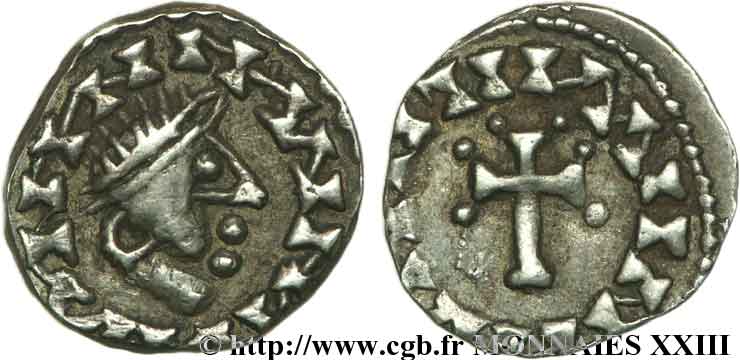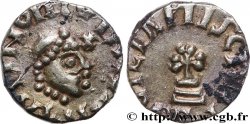v23_0905 - AURELIANORUM CIVITAS - ORLÉANS (Loiret) Denier
MONNAIES 23 (2004)
Starting price : 450.00 €
Estimate : 750.00 €
Realised price : 865.00 €
Number of bids : 9
Maximum bid : 1 000.00 €
Starting price : 450.00 €
Estimate : 750.00 €
Realised price : 865.00 €
Number of bids : 9
Maximum bid : 1 000.00 €
Type : Denier
Date: (VIIe - VIIIe siècles)
Mint name / Town : Orléans (?)
Metal : silver
Diameter : 11 mm
Orientation dies : 9 h.
Weight : 0,95 g.
Rarity : R3
Coments on the condition:
Denier complet et bien frappé, avec une pseudo-légende stylisée. Patine grise d’ancienne collection
Catalogue references :
Predigree :
Cet exemplaire aurait été acheté en décembre 1956
Obverse
Obverse legend : PSEUDO-LÉGENDE.
Obverse description : Tête radiée à droite ; légende dégénérée autour et grènetis.
Reverse
Reverse legend : PSEUDO-LÉGENDE.
Reverse description : Croix latine, dont les bras supérieurs sont ornés de deux globules ; légende dégénérée autour et grènetis.
Commentary
Ce type de croix est à rattacher à la "croix orléanaise". Les légendes, tant du droit que du revers sont complètement stylisées, remplacées par une suite de deux petits triangles opposés par leur sommet et joints aléatoirement par des petits traits. En l'absence de légende, il n'est possible de proposer une attribution pour cette monnaie qu'en se basant sur le style. Ce type de denier, avec une légende encore lisible et le même type de croix est classé à Orléans (cf. Belfort n° 505 à 520). Les monétaires figurant dans ce recensement sont AVDOOE, DOMVLFVS, DOGOMARVS, LONEGISELVS, LIEDEGIE et MAVRINVS. La légende du droit ou du revers doit être AVRELIANIS CIVITA, avec le nom de l'autre côté. Ce type de denier fut également frappé à Poitiers.








 Report a mistake
Report a mistake Print the page
Print the page Share my selection
Share my selection Ask a question
Ask a question Consign / sell
Consign / sell
 Full data
Full data